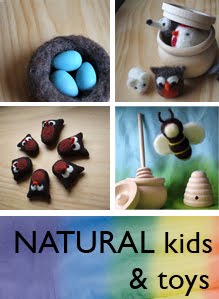here are some notes i took from the waldorf connection webcast with carrie dendtler from the parenting passageway talked about the first seven year cycle. carrie's website has an immerse achive of waldorf and parenting information. it is a wonderful resource.
why we do the things we do:
1. love, basis of everything we do
2. holistic view of the human being
3. the first seven year cycle is the foundation for the being
first year-walk, second year-speak, third year-think
birth - 2 1/2 becoming upright, learning to walk.
2 1/2 - 5 speaking, memory begin, play begin, first self-awareness at age 3
5-7 children becomes more conscious of the thoughts to what they say
what you bring to your children in these early years is important and it does matter.
- if feeling a little pressure, moms should pat themselves on the backs for trying to having a mindful, conscious, gentler, holistic approach which was different then your raised or saw in your family and for working on their inner path
- as long as you are trying and striving and your children see it
- forgive ourselves for not being perfect, we all can fall short at times, be kind to yourself, show your children how to have grace when you make a mistake
- we are fulfilling a need in our children and they are fulfilling a need within us, together
- relax, more about enjoying the process, not worrying if it is all not perfect, it is not about perfection in the end
- it is about healing and going on from where you are
qualities to bring to a young child
1. love and warmth (physical warmth, warm clothes, warming foods, through a home. a home that is warm emotionally and through delight in your child
work as parent is to be connected and loving to a child who is being more difficult than normal. personal development of parent, inner work, be calm, meet child where they are
2. an environment that nourishes those senses. repetition, rhythm, developing the sense of touch, sense of balance, sense of life, sense of movement, everything a child sees or hears. child is seen as a sensory being, with no filters from the world. when child is taking in impressions we need to give a child something worthy to imitate
3. creative, artistic experiences, handwork, painting, modeling
*the first handwork and creative experiences for children is playing with sand, playing in the mud, being outside in all types of weather, polishing shoes, kneading bread, puppetry is a wonderful artistic experience for children (juniper tree puppets, take simple things, simple story lines, nourish a child's soul), look more at the practical things within our home
4. meaningful adult activity that the child can imitate in their play. do something with your hands. loving, rhythmic home life, show them practical work, do tasks for your family in a loving manner, in a joyful manner, sing. do these things because you love your family. let children help. no need to rush through the task. really get into that task and do it joyfully. so your child can see, this is our family and we love each other, this is how we nourish each other
5. free play. children are at the height of imitation. they need to see you doing practical work, they need to get outside to use some of that energy so they can settle down inside. may need to have you help them a little bit, set up play scenarios. how can I make my child's play more creative? arrange toys so they are inviting for play. all toys have a home, that we could really show gratitude and reverence for toys. get outside to get energy out (2-4 hours a day, experiment with the elements, nature stories nourishing to their souls, connecting child to nature) going outside, connecting child to nature, important for disciplining as well
6. growing gratitude, reverence, wonder. the way we take care of our family, the way we do our tasks around the home, the blessings we have before meals, having a place for everything in the home, the wonder of nature
7. humor and happiness. play with them, do silly things, hug them, pat them on the back, play with them, kiss them, smile at them, give them that warm gesture, not using so many words. work with your child, through their body, through movement, fantasy and imagination. what could you do to get their energy out, use that in a creative way and also lead to what needs to be done. the boundaries still need to be held. keep to what is important in your home, what is the flow in your home, what are the rules in your home, what is the rhythm in your home. your rhythm really should carry the disciplining stuff for the younger crowd. having realistic expectations for the age and what a child can do.
8. adult caregivers who are trying to pursue a path of inner development. our actions are worthy of imitation. developing our own will of taking children outside when we would rather be inside.
child inclusive = i am setting the rhythm and tone of my home because i have more experience living on this earth and you deserve so much love, warmth and dignity. and i am going to show you how our family should do things. i am going to include you in all these tasks. here is your part to help. we are going to have time to play, we have time to go outside, and we are going to have time to sit down and have a warm family meal together.
i set it with love and attention to what my child needs are and feelings are, the art of parenting. i know when to follow that rhythm. a flow to your day. lovingly take into account the things that they needs, getting their energy out, creative play, warmth, worthy work to imitate, creative experiences, free play.
disciplining 4 1/2 years = children have a lot of energy and opinions. outside time to diffuse that. strong, steady rhythm, things happen in a strong and steady flow so they know what to expect, to have those have warmth for the child. find support for yourself, finding ways to fill your own tank. if you want to teach a behavior to your child one of the best ways is to do it in front of them. preserving the dignity of the child, having respect for the child and where they are. have tools in your tool bag, use humor, no need to be so serious, letting things go, ignoring things, "picking your battles", use distraction, solve things with warm, protecting gestures, pictorial imagery, positive places with imagery "hop like a bunny over here", phasing it as positively as you can. look at your child sleeping, how innocent and little they are. have a good grasp of realistic expectation for your child.understand where they are coming from. use less words. use gestures. can i say something calming and peaceful to my child. is this worth it? does this have to be addressed right now? child is learning, new and different things.
- sibling rivalry. you need a bag of tricks. when things are falling apart, have something calming. gather for a story. when things are clam, you try and make restitution. give child power to fix what was going wrong. as parent, have your bag of tricks to hold the space more closely
-dad being a part of bedtime routine in a calming way. a warming routine. back rubs. rocking small child. telling a story, singing. dad to decompress on your way home from work. steady routine, cultivating weekends for roughhousing, rough play, outside play
books mentioned:
you're not the boss of me
how to raise your children without sibling rivalry
________________________________________________________
the waldorf connection webcast featured eileen from little acorn learning. here are some of her thoughts on celebrating spring
lent. think about sacrifice, think of something to give up. as adults, self-reflection, what you could give up or what you could give better of yourself. can you give up negative thinking, worrying, regret? as we prepare for spring, as mother's we could prepare ourselves, a rebirth, a new, wake ourselves up, inner work to start a new season in our lives with our children. examine our lives and where you'd like to be. maybe give yourself 15 minutes of quiet, maybe a yoga class.
preparing our homes. decorating within the season. different colors. spring cleaning. declutter. recycle old toys. go through clothes. get down to the basics. less is more. donate items. reuse some of these things. do i really need all this stuff? emphasis on less is more. children just need the space to just be.
spring cleaning with the children. make it a point to include them in our tasks. find the patience within us to include them in our work. it gives them a purpose.
seasonal nature table. display symbols of the season in your home. signs of life. small plants. seedlings. empty nests. display the four elements. earth=soil or plant. water, air=pinwheel or kite, fire=beeswax candle.
she went on to discuss spring activities, such as composting, growing corn. if you would like to hear the series on the waldorf connection, they could be purchased.
Monday, February 22, 2010
waldorf connection - first seven year cycle & celebrating spring
Labels:
finding rhythm,
homeschooling | unschooling,
welcoming spring
at
Monday, February 22, 2010
Posted by
christine ~ ourdayourjourney


Subscribe to:
Post Comments (Atom)








2 comments:
this was wonderful! thank you for sharing what you learned.
Thank you for posting this wonderful recap! I was unable to get over to the Walforf connection and love how you put all the information together :)
blessings!
Post a Comment